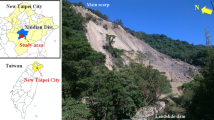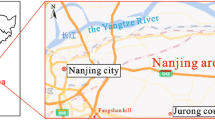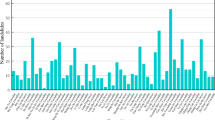Abstract
This case study is about a landslide that occurred after 4 days of heavy rainfall, in the morning of June 29, 2012, in Cengong County, Guizhou Province of China, geographical coordinated 108°20′-109°03′E, 27°09′-27°32′N, with an estimated volume of 3.3×106 m3. To fully investigate the landslide process and formation mechanism, detailed geotechnical and geophysical investigations were performed including borehole drilling, sampling, and laboratory tests coupled with monitoring of displacement. Also, a combined seepage-slope stability modeling was performed to study the behavior of the landslide. After the heavy rainfall event, the sliding process started in this area. The landslide development can be divided into different parts. The man-made fill area, spatially distributed in the south side of the landslide area with low elevations, slid first along the interface between the slope debris and the strongly weathered bedrock roughly in the EW direction. Consequently, due to severe lateral shear disturbance, the slope in the main sliding zone slid next towards the SW direction, along the sliding surface developed within the strongly weathered calcareous shale formation located at a depth of 25-35 m. This means it was a rainfall triggered deep-seated landslide. Finally, retrogressive failure of a number of upstream blocks occurred, which moved in more than one direction. The initial failure of the man-made fill area was the ‘engine’ of the whole instability framework. This artificial material with low permeability, piled up in the accumulation area of surface and sub-surface and destroyed the drainage capacity of the groundwater. The numerical modeling results agreed with the analysis results obtained from the laboratory and field investigations. A conceptual model is given to illustrate the formation mechanism and development process of the landslide.
Similar content being viewed by others
References
Aleotti P (2004) A warning system for rainfall-induced shallow failures. Engineering Geology 73(3):247–265. https://doi.org/10.1016/j.enggeo.2004.01.007
Alonso EE, Gens A, Delahaye CH (2003) Influence of rainfall on the deformation and stability of a slope in over consolidated clays: a case study. Hydrogeology Journal 11:174–192. https://doi.org/10.1007/s10040-002-0245-1
Au SWC (1998) Rain-induced slope instability in Hong Kong. Engineering Geology 51:1–36. https://doi.org/10.1016/S0013-7952(98)00038-6
Benac C, Arbanas Ž, Jurak V, et al. (2005) Complex landslide in the Rjecina valley (Croatia): origin and sliding mechanism. Bulletin of Engineering Geology and the Environment 64(4):361–371. https://doi.org/10.1007/s10064-005-0002-5
Caine N (1980) The rainfall intensity — duration control of shallow landslides and debris flows. Geografiska Annaler Series A 62:23–27. https://doi.org/10.2307/520449
Canuti P, Focardi P, Garzonio CA (1985) Correlation between rainfall and landslides. Bulletin of the International Association of Engineering Geology 32:49–54. https://doi.org/10.1007/BF02594765
Casagli N, Dapporto S, Ibsen ML, et al. (2006). Analysis of the landslide triggering mechanism during the storm of 20th-21st November 2000, in Northern Tuscany. Landslides 3(1):13–21. https://doi.org/10.1007/s10346-005-0007-y
Chelli A, Mandrone G, Truffelli G (2006) Field investigations and monitoring as tools for modelling the Rossena castle landslide (Northern Appennines, Italy). Landslides 3(3):252–259. https://doi.org/10.1007/s10346-006-0046-z
Crosta GB (1998) Regionalization of rainfall thresholds: an aid to landslide hazard evaluation. Environmental Geology 35(2-3):131–145. https://doi.org/10.1007/s002540050300
Dahal RK, Hasegawa S (2008) Representative rainfall thresholds for landslides in the Nepal Himalaya. Geomorphology 100(3-4):429–443. https://doi.org/10.1016/j.geomorph.2008.01.014
Floris MD, Alpaos A, Squarzoni C, et al. (2010) Recent changes in rainfall characteristics and their influence on thresholds for debris flow triggering in the Dolomitic area of Cortina d’Ampezzo, north-eastern Italian Alps. Natural Hazards and Earth System Sciences 10:571–580. https://doi.org/10.5194/nhess-10-571-2010
Guzzetti F, Peruccacci S, Rossi M, Stark CP (2007) Rainfall thresholds for the initiation of landslides in central and southern Europe. Meteorology and Atmospheric Physics 98(3-4):239–267. https://doi.org/10.1007/s00703-007-0262-7
Hong Y, Hiura H, Shino K, et al. (2005) The influence of intense rainfall on the activity of large-scale crystalline schist landslides in Shikoku Island, Japan. Landslides 2:97–105. https://doi.org/10.1007/s10346-004-0043-z
Hungr O, Leroueil S, Picarelli L (2014) The Varnes classification of landslide types, an update. Landslides 11(2):167–194. https://doi.org/10.1007/s10346-013-0436-y
Ibsen ML, Casagli N (2004) Rainfall patterns and related landslide incidence in the Porretta-Vergato region, Italy. Landslides 1(2):143–150. https://doi.org/10.1007/s10346-004-0018-0
Iverson RM (2001) Landslide triggering by rainfall infiltration. Water Resources Research 36(7):1897–1910. https://doi.org/10.1029/2000WR900090
Iverson RM, Major JJ (1987) Rainfall, ground-water flow, and seasonal movement at Minor Creek landslide, northwestern California: physical interpretation of empirical relations. Geological Society of America Bulletin 99:579–594. https://doi.org/10.1130/0016-7606(1987)992.0.CO;2
Kanungo DP, Sharma S (2014) Rainfall thresholds for prediction of shallow landslides around Chamoli-Joshimath region, Garhwal Himalayas, India. Landslides 11(4):629–638. https://doi.org/10.1007/s10346-013-0438-9
Kuo YS, Tsai YJ, Chen YS, et al. (2013) Movement of deep-seated rainfallinduced landslide at hsiaolin village during typhoon morakot. Landslides 10(2):191–202. https://doi.org/10.1007/s10346-012-0315-y
Matsuura S, Asano S, Okamoto T (2008) Relationship between rain and/or meltwater, pore-water pressure and displacement of a reactivated landslide. Engineering Geology 101(1):49–59. https://doi.org/10.1016/j.enggeo.2008.03.007
Prountzopoulos G, Fortsakis P, Seferoglou K, et al. (2014). Assessment of failure mechanism and rehabilitation of a landslide within marly formations in NW Greece: from the site investigation to the geotechnical design. Geotechnical and Geological Engineering 32(6):1485–1502. https://doi.org/10.1007/s10706-014-9729-8
Schulz WH, Mckenna JP, Kibler JD, Biavati G (2009) Relations between hydrology and velocity of a continuously moving landslide - evidence of pore-pressure feedback regulating landslide motion. Landslides 6(3):181–190. https://doi.org/10.1007/s10346-009-0157-4
Topsakal E, Topal T (2015) Slope stability assessment of a re-activated landslide on the Artvin-Savsat junction of a provincial road in Meydancik, Turkey. Arabian Journal of Geosciences 8(3):1769–1786. https://doi.org/10.1007/s12517-013-1210-0
Tsai TL (2008) The influence of rainstorm pattern on shallow landslide. Environmental Geology 53(7):1563–1569. https://doi.org/10.1007/s00254-007-0767-x
Van Asch TWJ, Buma J, Van Beek LPH (1999) A view on some hydrological triggering systems in landslides. Geomorphology 30:25–32. https://doi.org/10.1016/S0169-555X(99)00042-2
Vassallo R, Grimaldi GM, Maio CD (2015) Pore water pressures induced by historical rain series in a clayey landslide: 3D modeling. Landslides 12(4):731–744. https://doi.org/10.1007/s10346-014-0508-7
Vita PD, Reichenbach P, Bathurst JC, et al. (1998) Rainfall-triggered landslides: a reference list. Environmental Geology 35 (2-3): 219–233. https://doi.org/10.1007/s002540050308
Wang G, Suemine A, Furuya G, et al. (2005) Rainstorm-induced landslides at Kisawa village, tokushima prefecture, Japan, August 2004. Landslides 2(3):235–242. https://doi.org/10.1007/s10346-005-0061-5
Wu CH, Chen SC, Feng ZY (2014) Formation, failure, and consequences of the Xiaolin landslide dam, triggered by extreme rainfall from Typhoon Morakot, Taiwan. Landslides 11(3):357–367. https://doi.org/10.1007/s10346-013-0394-4
Zêzere JL, Trigo RM, Trigo IF (2005) Shallow and deep landslides induced by rainfall in the Lisbon region (Portugal): assessment of relationships with the North Atlantic Oscillation. Natural Hazards & Earth System Sciences 5(3):1313–1314. https://doi.org/10.5194/nhess-5-331-2005
Zêzere JL, Vaz T, Pereira S, et al. (2015) Rainfall thresholds for landslide activity in Portugal: a state of the art. Environmental Earth Sciences 73(6):2917–2936. https://doi.org/10.1007/s12665-014-3672-0
Acknowledgements
This research was financed by the Research Foundation of SKLGP (Nos. SKLGP2015Z014, SKLGP2016Z013, SKLGP2016Z018). The authors thank LI Long and BU Xiang-cheng for performing in situ measurements and WANG Qian for her work on laboratory tests. The first author would like to thank the SKLGP and CDUT for providing a scholarship to conduct a part of the reported research at the University of Arizona as a Visiting Research scholar.
Author information
Authors and Affiliations
Corresponding author
Electronic supplementary material
Rights and permissions
About this article
Cite this article
Huang, Qx., Xu, Xt., Kulatilake, P.H.S.W. et al. Formation mechanism of a rainfall triggered complex landslide in southwest China. J. Mt. Sci. 17, 1128–1142 (2020). https://doi.org/10.1007/s11629-019-5736-9
Received:
Revised:
Accepted:
Published:
Issue Date:
DOI: https://doi.org/10.1007/s11629-019-5736-9




